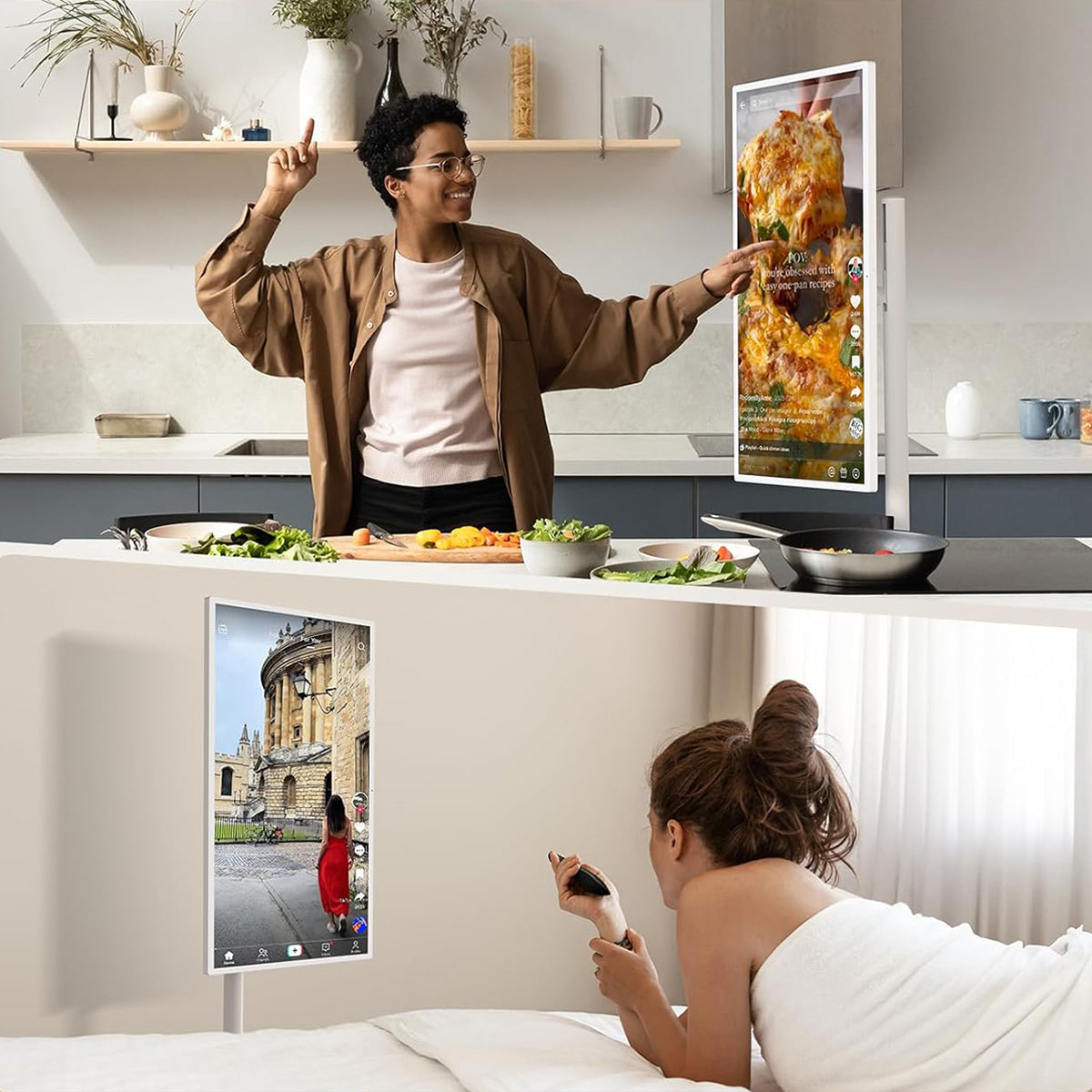Table of Contents
- Why Is Color Accuracy Important in Displays?
- What Is sRGB?
- What “sRGB 100%” Means?
- Why Color Accuracy Matters in Portable TVs?
- How GFF’s sRGB 100% Display Delivers Precision?
- Let’s Compare sRGB, DCI-P3, and Adobe RGB
- How to Test Your Display’s Color Accuracy?
- How Color Accuracy Affects Your Eyes and Experience?
- The Future of Display Color Standards
Whether shopping for a portable TV or monitor, you must have read the term sRGB or sRGB 100% highlighted in the specifications. Wondering what it means? And why is it important for users?
This article will discuss what is sRGB? Why is color accuracy important, and how does having an sRGB 100% cover ensure richer, true-to-life visuals? Plus, we will also explore how GFF delivers precise color performance. Is it better than other color gamuts? How to test color accuracy at home, where displays are headed in the future, and who sells the best ones?
Why Is Color Accuracy Important in Displays?
A TV display with sRGB 100% coverage means the display can reproduce the whole standard color spectrum used for digital content. According to BJYP, this display coverage translates digital content into an immersive experience.
This is because the digital world: streaming, photography platforms, mobile apps, and websites mainly use the sRGB color space. You see an accurate, consistent, and close to the creator’s intent when the display hits sRGB 100%. This full sRGB coverage offers clarity and realistic visuals, whether you are editing photos, watching movies on a portable TV, or enjoying vibrant visuals. High color accuracy also decreases dullness or oversaturation, resulting in a balanced and comfortable viewing experience across different media types.
What Is sRGB?
Many ask: What is sRGB? It stands for “Standard Red Green Blue”. Microsoft and HP developed this to create uniformity across digital devices. sRGB defines the range of colors that most printers, screens, and browsers use, making it the universal standard for all digital visuals. A display that covers this color space guarantees to deliver predictable and accurate color reproduction. This is great because now almost all online images, graphics, and videos are created in sRGB. In short, it’s digital color’s baseline language. A shared system that keeps colors consistent across devices.
What “sRGB 100%” Means?
A display claiming sRGB 100% means the screen can reproduce the whole sRGB color space without missing or altering shades. Therefore, instead of washed-out or oversaturated visuals, this leads to vivid, but realistic colors. A display with less than 100% coverage might struggle with particular tones like greens and reds.
For daily users, sRGB100% display gives you exactly what content creators want to see. In the case of designers, video editors, or photographers, it’s necessary for accuracy. And for those with a portable TV, you get to see realistic visuals from sports broadcasting to gaming visuals.

Why Color Accuracy Matters in Portable TVs?
Modern portable TV users want their compact screens to perform like full-size televisions. Here, color accuracy determines how immersive your experience is. No matter whether you are streaming movies outdoors, watching tutorials, or gaming on the go.
When seated in natural lighting conditions, accurate colors respond better. This prevents distorted skin tones and offers more dynamic contrast. As the demand for portable screens increases, displays with sRGB100% coverage ensure sharp details, consistent image quality, and lifelike shades.
It is especially essential for small screens, where inaccuracies are quickly noticeable. In short, color accuracy boosts the overall portable display’s visual performance.
How GFF’s sRGB 100% Display Delivers Precision?
GFF’s display technology is crafted to deliver you with a reliable sRGB 100% performance. It guarantees to offer exceptional color accuracy across various lighting conditions. The screens use premium backlighting, enhanced pixel uniformity, and advanced panel calibration. This helps them to produce vibrant yet realistic colors perfect for both entertainment and work.
The brand’s panel further offers consistent color reproduction, whether installed in a portable TV or any integrated device. These displays align with the industry standards, reducing color drift, enhancing shadow details, and maintaining brightness stability, which matters a lot for content creators, designers, and daily users. Users can count on GFF to work because on-screen visuals appear as intended.
Let’s Compare sRGB, DCI-P3, and Adobe RGB
Yes, sRGB is the most widely used color space, but it’s not the only one. Let’s compare it with the other major color gamuts: DCI-P3 and sRGB, so you understand why sRGB remains preferred:
sRGB
sRGB is used for websites, mobile applications, social platforms, and most consumer devices. It is a digital standard offering a moderate color range that works well in typical environments. Perfect for using portable TVs and general displays. Full sRGB coverage promises to offer consistent, predictable color accuracy as most digital content is mastered in this only.
DCI-P3
DCI-P3 was originally developed for digital cinema. It provides a wider color gamut than sRGB. About 25-30% larger. This means the color gamut displays deeper reds, richer contrast, and more saturated greens. Several modern smartphones and high-end monitors now use P3 as it delivers a more cinematic appearance. However, not all content is P3-friendly, resulting in oversaturation in some cases. For those who watch movies or play games on premium devices, get ready to enjoy an enhanced visual experience.
Adobe RGB
Adobe RGB is designed for professional photography and printing. It covers even more of the green spectrum than sRGB. Ideal for design studios, photo editing, and print production. However, very few consumer displays, including portable TVs, support full Adobe RGB. Because this exceeds what typical media ask for. Perfect for professionals working with physical prints or advanced color grading.
What’s Best?
sRGB 100% remains the most practical, especially for those using portable screens. While Adobe RGB and P3 offer broader color gamuts, they are specialized and not even universally supported. Therefore, sRGB wins the race, delivering the most consistent and authentic color experience for viewing digital content.
How to Test Your Display’s Color Accuracy?
You don’t need professional equipment for testing a screen’s color accuracy. Although there are tools like colorimeters to provide precise results. For daily users, many simple methods help assess whether your display meets sRGB 100% performance:
Use Online Color Tests
Use websites like Eizo Monitor Test, Lagom, or DisplayCAL. Their charts help examine gradients, saturation, and contrast. If colors appear consistent and smooth, your portable TV is calibrated well.
Check for Banding
This is gradient branding. Here, colors transition in steps rather than smooth blends. It is a common sign of poor color performance.
Compare with Reference Images
View professionally calibrated images. Compare them on multiple screens. This reveals inaccuracies like oversaturated tones or tinted whites.
Enable Color Profiles
The majority of the operating systems offer color profile settings. Make sure you select the sRGB profile for accurate reproduction.
Use Mobile Apps
Use mobile apps such as Datacolor SpyderX or Calibrite. Both measure and adjust your screen’s accuracy with external sensors.
If you have a portable TV that supports sRGB color modes. Enable them to receive optimal visual performance and consistent viewing.
How Color Accuracy Affects Your Eyes and Experience?
It Affects Comfort and Visual Health
Portable TVs with color-accurate displays are not limited to improving image quality. They also affect visual health and comfort. Screens that disturb colors usually offer overly bright, unbalanced images, or washed-out images. This results in eye strain during long viewing sessions. But, displays with sRGB 100% coverage maintain natural tones and consistent contrast. Your eyes don’t feel uncomfortable.

Consistently Delivers Accurate Colors
For anyone watching movies or browsing on a portable TV, accurate colors guarantee to keep shadows, highlights, and mid-tones appear consistent. This makes it easier for your eyes to adapt. The outcome? Cognitive load linked with processing distorted visuals reduces.
Enhances Immersion
Accurate hues make content more realistic. Irrespective of whether you are gaming, watching videos, or editing content. Skin tones look natural, and landscapes don’t look uneven. Plus, graphics remain true to their intended style. In the long run, accuracy results in a more enjoyable and comfortable viewing experience. This especially happens on portable screens used in various lighting conditions.
The Future of Display Color Standards
Developing Expectations for Color Accuracy
Color accuracy expectations continue to develop. The same goes for visual performance as well. sRGB remains the most widely used color standard, but DCI-P3, Rec. 2020, and various HDR-compatible color spaces are pushing modern displays’ boundaries. These expanded gamuts deliver higher contrast, more dynamic visual ranges, and richer saturation. Ideal for next-generation 4K, 8K, and HDR content.
Next-Generation Portable Displays
Portable screens, including portable TVs, are swiftly improving as new technologies become more accessible. These are mini-LED, OLED, and quantum-dot panels. Both allow compact devices to achieve wider color ranges and higher brightness. No worries, it won’t compromise the battery life.
In 2026, portable displays may regularly exceed sRGB 100%, providing cinema-grade visuals in travel-friendly formats.
Intelligent Color Management
AI-driven calibration tools are also changing how screens handle color. The intelligent color management automatically adjusts the screen’s color profile. This is done based on ambient lighting, user preferences, and content type, ensuring consistent accuracy.
Why sRGB Will Still Matter?
Despite technical advancements, sRGB remains an essential foundation. Primarily because it universally supports digital content. As wider gamuts grow, it ensures the consistency required for everyday creation and viewing.
Conclusion
We hope you understand sRGB’s importance. It plays a vital role in offering visual vibrancy for everyday users and professionals. So, if you want to buy a portable TV on wheels, purchase from GFF-AI.
About the Author:
Nana Xu is a tech writer and product enthusiast who focuses on smart home devices and innovative display technologies. With a passion for user-friendly design and new trends in consumer electronics, she helps readers make smarter choices for modern living.





